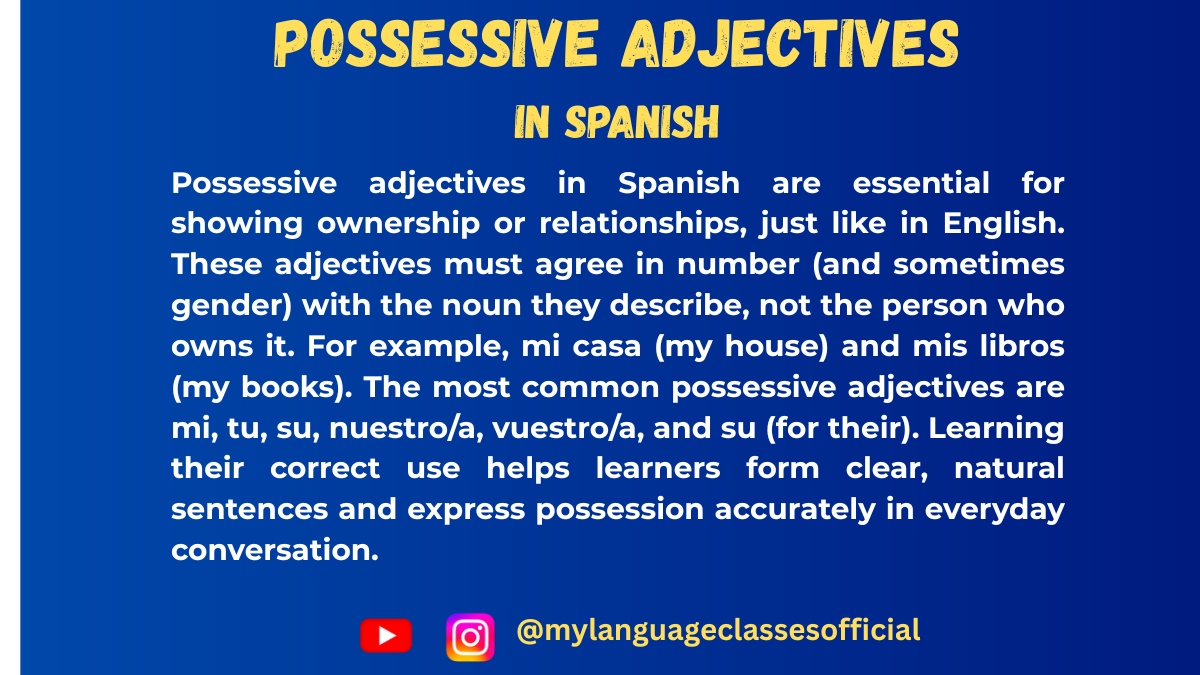Your cart is currently empty!
Tag: Spanish possessive pronouns vs adjectives
-

Possessive Adjectives in Spanish
Possessive adjectives in Spanish are essential for indicating ownership or relationships. They agree in gender and number with the noun they modify and are categorized into two forms: short-form possessive adjectives and long-form possessive adjectives.
Short-Form Possessive Adjectives
These adjectives come before the noun and agree only in number (except for “nuestro” and “vuestro,” which also agree in gender).
Singular Possessor Singular Noun Plural Noun mi (my) mi casa (my house) mis casas (my houses) tu (your, informal) tu coche (your car) tus coches (your cars) su (his, her, its, your formal) su perro (his dog) sus perros (his dogs) nuestro/a (our) nuestro amigo (our friend) nuestros amigos (our friends) vuestro/a (your, plural informal) vuestra madre (your mother) vuestras madres (your mothers) su (their, your plural formal) su profesor (their teacher) sus profesores (their teachers) Examples Sentences:
- Mi casa es grande. (My house is big.)
- Tus zapatos son nuevos. (Your shoes are new.)
- Su hermano vive en Madrid. (His brother lives in Madrid.)
- Nuestra escuela es moderna. (Our school is modern.)
- Vuestras mochilas están en la mesa. (Your backpacks are on the table.)
- Sus ideas son interesantes. (Their ideas are interesting.)
Long-Form Possessive Adjectives
These adjectives come after the noun and agree in both gender and number with the noun. They emphasize ownership.
Singular Possessor Singular Masculine Singular Feminine Plural Masculine Plural Feminine mío/a (mine) el libro mío (my book) la casa mía (my house) los libros míos (my books) las casas mías (my houses) tuyo/a (yours, informal) el coche tuyo (your car) la bolsa tuya (your bag) los coches tuyos (your cars) las bolsas tuyas (your bags) suyo/a (his, hers, yours formal) el perro suyo (his dog) la idea suya (her idea) los perros suyos (his dogs) las ideas suyas (her ideas) nuestro/a (ours) el amigo nuestro (our friend) la profesora nuestra (our teacher) los amigos nuestros (our friends) las profesoras nuestras (our teachers) vuestro/a (yours, plural informal) el coche vuestro (your car) la casa vuestra (your house) los coches vuestros (your cars) las casas vuestras (your houses) suyo/a (theirs, yours plural formal) el libro suyo (their book) la comida suya (their food) los libros suyos (their books) las comidas suyas (their foods) Examples Sentences:
- Esa mochila es mía. (That backpack is mine.)
- El coche rojo es tuyo. (The red car is yours.)
- La casa grande es suya. (The big house is his/hers.)
- La responsabilidad es nuestra. (The responsibility is ours.)
- El problema es vuestro. (The problem is yours.)
- Las ideas son suyas. (The ideas are theirs.)
Key Differences Between Short and Long Forms
- Position in the sentence: Short forms come before the noun; long forms come after the noun.
- Emphasis: Long forms emphasize possession and ownership more strongly.
- Agreement: Long forms agree in both gender and number, whereas short forms only change for number (except “nuestro” and “vuestro”).
Common Expressions Using Possessive Adjectives
Here are some useful phrases commonly used in daily life:
Spanish English Mi amor My love Mi casa es tu casa My house is your house (Feel at home) A su servicio At your service En su tiempo libre In his/her free time A mi manera In my way A su gusto To his/her liking Nuestros pensamientos Our thoughts Vuestra responsabilidad Your responsibility Lo mío es importante What is mine is important Un amigo mío A friend of mine Example Sentences Using Expressions:
- Mi casa es tu casa, siéntete cómodo. (My house is your house, make yourself comfortable.)
- A su gusto, puede elegir cualquier opción. (To his/her liking, they can choose any option.)
- En su tiempo libre, le gusta leer. (In his/her free time, he/she likes to read.)
- Nuestros pensamientos son similares. (Our thoughts are similar.)
Things to Keep in Mind When Using Possessive Adjectives
- Article Usage: Short-form possessive adjectives do not need an article, while long-form adjectives can be used with definite articles (el, la, los, las):
- Mi coche es rojo. (My car is red.)
- El coche mío es rojo. (The car of mine is red.)
- Plural and Gender Agreement:
- If the noun is plural, the possessive adjective must be plural.
- If the noun is feminine, adjectives ending in -o change to -a (e.g., “mío” → “mía”).
- Ambiguity of “su/sus”: “Su” and “sus” can mean “his, her, their, your (formal),” leading to confusion. To clarify, use “de + pronoun/name”:
- Su coche es nuevo. (His/her/your/their car is new.)
- El coche de Juan es nuevo. (Juan’s car is new.)
- El coche de ellos es nuevo. (Their car is new.)
Final Thoughts
Possessive adjectives are an integral part of Spanish grammar, making conversations clearer and more precise. Understanding the difference between short and long forms, as well as their proper agreement with nouns, will greatly improve your fluency. Practice using these adjectives in daily conversations, and soon, they’ll become second nature!
Did you find this guide helpful?
Let us know in the comments below or practice by writing a few sentences using possessive adjectives!
If you enjoyed this lesson, be sure to check out more posts like this on my blog at My Language Classes. Don’t forget to subscribe my YouTube channel and follow me on Instagram for the latest language learning tips and lessons. Leave a comment below to share your thoughts, or ask any questions you have.
Happy learning! 😊
